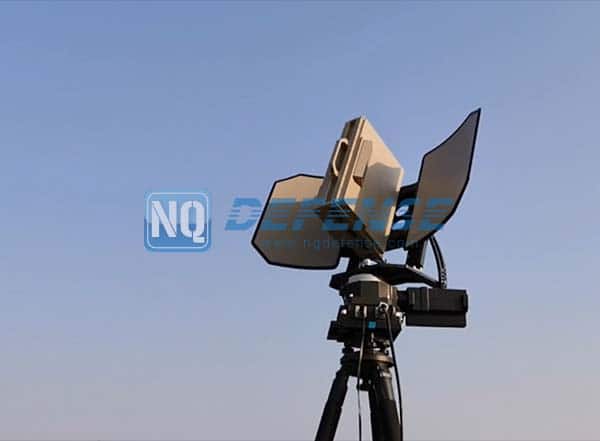
Anti-Drone Radar Detector
Radar technology has been widely adopted in anti-drone solutions for effectively tracking the target trajectory. For anti-drone applications, the key is to use high-resolution radar to detect small drones with RCS of around 0.01 m² within typical distance. Many radars, such as pulse radars, have been designed to detect large metal objects like airplanes and helicopters, which are not suitable for detecting objects with small RCS, low flying height, and slow flying speed. For evaluating anti-drone solutions, the following factors shall be considered.
Filtering out Ground Clutter Waves
Ground clutter waves will interfere with radar detection. Furthermore, objects such as trees and buildings will cause large-area false reflection which could overwhelm the drone signal reflection. Advanced radars will apply various technologies to filter out these clutter waves.
Azimuth Angle Coverage
The azimuth angle is the horizontal coverage angle of the radar. A typical coverage range is from 60° to 120°. Multiple radars could be deployed for a large-angle coverage, even 360° coverage. Single set of ND-BU001, ND-BU002 or ND-BU003 could achieve 360° all-round coverage.
Pitch Angle Coverage
The pitch angle is easily overlooked when evaluating anti-drone solutions. In the market, many drone radars have very narrow pitch angles (between 10°~30°), which will cause huge blind zone out of the pitch coverage. Although a 90-degree vertical coverage is usually not necessary, the ideal pitch angle for detection shall be around 40°~80°. The pitch angle coverage of both ND-BU001 and ND-BU002 have reached the ideal range.
3D Radar Advantages
Compared to 2D radars, 3D radars have several advantages, of which the most notable is that altitude information of detected drones can be achieved. With this function, 3D drone radars could reduce clutter waves by filtering objects above a certain height, which will eliminate false alarms. Both ND-BU001 and ND-BU002 adopt 3D radar technology for powerful functions.
Radar Frequency Bands
Anti-drone radar bands include X-band (also commonly used on ships), K-band (originally used for self-driving vehicles, while suitable for anti-drone solutions), Ku-band, and S-band (compatible with military deployments). The size of the drone radar also depends on the bands used. For example, usually the size of the K-band radar is smaller.
Mobile/Fixed Panel
Generally, the fewer moving part the better the drone radar. Because this can reduce the possibility of wear and damage. Some radars can be used in both “gaze” and rotation modes. Gaze mode provides better detection and tracking performance, while the coverage angle is less than that of rotation mode.
Besides, mainstream radar technology methods for drone detection include pulse (active), continuous wave (active), and passive mode. Each method has its own characteristics with advantages and disadvantages.
Active Radar-Pulse
The radar transmits a very short but high-power pulse, and waits for the reflected echo pulse from the target. The reduction in the time window between the transmitting pulse and echo pulse will affect the performance. The narrower the pulse width, the higher the distance resolution. Pulse radars could provide instantaneous high-power output, as such, they are generally designed for long-distance detection.
Active Radar-Continuous Wave
The radar continuously transmits radio frequency signals and receives the reflected echo simultaneously. Influenced by Doppler effect, the receiver could calculate the speed and trajectory of the target by measuring the frequency shift. The continuous wave radar can’t calculate distance without timing reference in the transmitting signal. Both ND-BU001 and ND-BU002 adopt active continuous-wave radars, specifically for detecting small-size drones with low speed at low altitude.
Passive Radar
The passive radar detects targets within the receiving area by using existing environmental broadcast, communication signals, or radio navigation signals. The transmitter and receiver are located at different locations, while the user can only control the receiver. Potential transmitting signals used for drone detection include FM, DVB, GSM, GNSS, and Wi-Fi. The passive radar is quite attractive to end users who prefer non-transmitting equipment, as its detection operation won’t be easily noticed or interfered. Equipped with passive radar technology, ND-BU003 has obvious advantages in performance and price.
Choosing Suitable Drone Radar
After comprehensively considering the main factors above when evaluating anti-drone solutions, the next step is to choose the suitable drone radar. As an anti-drone radar with a very wide range of applications, active radar is able to efficiently detect, track and identify drone targets. By adopting 3D active phased-array radar, both ND-BU001 and ND-BU002 could achieve long detection range when searching and tracking multiple drone targets simultaneously.
Another anti-drone radar being adopted more and more in various application scenarios is passive radar. Unlike active radar, a passive radar does not emit radio waves, but processes signal from objects in the environment. By adopting passive radar (RF detector), the detection operation of ND-BU003 will not have electromagnetic interference to the surrounding environment.Another outstanding feature that makes passive radar dominate in the race for anti-drone radar lies in its compactness. ND-BU003 could search and detect drone targets in all directions and all weathers, with regional three-dimensional protection and easy installation.
To learn more about our Anti-Drone Radar features and specifications, please click the link below.
ND-BU001 Standard Anti-Drone System
ND-BU002 High End Anti-Drone System
ND-BU003 Passive Anti-Drone System
